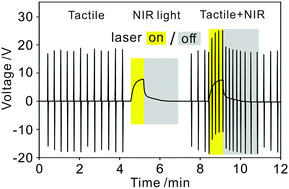Enhancing the tactile and near-infrared sensing capabilities of electrospun PVDF nanofibers with the use of gold nanocages†
Abstract
Owing to its piezoelectric and pyroelectric properties, poly(vinylidene fluoride) (PVDF) has been extensively explored for applications related to tactile sensing, energy harvesting, and thermal imaging. However, PVDF cannot be directly used to detect light because of its weak absorption in the visible and near-infrared (NIR) regions, preventing effective conversion from light to heat and then electrical signal. In this work, we address this issue by incorporating Au nanocages (AuNCs) into PVDF nanofibers during electrospinning. The strong and tunable optical absorption associated with AuNCs makes them an effective transducer for converting light to heat and then electrical signal. The presence of AuNCs and the strong electric field inherent to electrospinning both promote the formation of the ferroelectric β phase for maximal piezoelectric and pyroelectric conversions. With the incorporation of AuNCs, the electrospun PVDF nanofibers show enhanced capabilities for tactile and NIR sensing. While the voltage output under the tactile force is increased by 12.6-fold relative to the case of pristine PVDF nanofibers, a voltage output of 7.2 V is achieved when the hybrid device is subjected to the on/off cycles of NIR irradiation by an 808 nm diode laser at a power density of 0.2 W cm−2.

- This article is part of the themed collection: 2018 Journal of Materials Chemistry C HOT Papers


 Please wait while we load your content...
Please wait while we load your content...